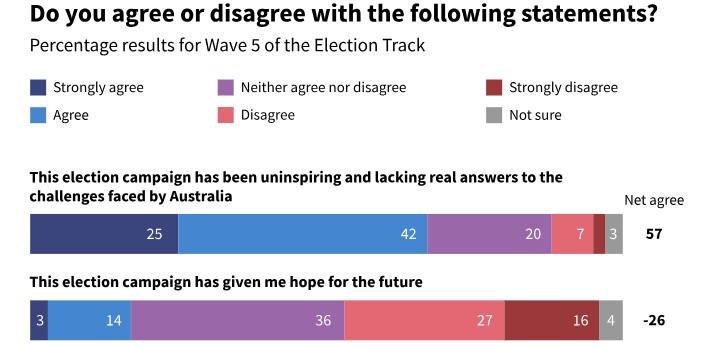The right did not “lose” this election, it was barely even contesting it. If the Liberals had won last weekend, it wouldn’t have made a meaningful difference to the policies of the Australian government over the next three years.
Labor’s victory was not by virtue of its policies (which we know are unpopular) or its popularity, but thanks to a failure of the Liberals to provide a genuine opposition that could inspire support. And this is a failure we should not lament, but recognise as heralding a great and unique opportunity to radically reshape the Australian Right in the coming years.
Australians did not go to the polls with enthusiasm, according to AEC figures we are on track for a record low voter turnout, and of the people who did show up to vote about as many cast informal votes as voted for One Nation (the fourth best performing party in the election, who achieved their highest primary vote since 1998). Labor won in a “landslide” despite not even getting 5 million votes out of 18.5 million eligible voters in a “compulsory” voting system.
A Redbridge poll conducted in the fortnight before the election asked respondents if they agreed with the statement “this election campaign has been uninspiring and lacking real answers to the challenges faced by Australia”, 67% strongly agreed or agreed, only 10% disagreed or strongly disagreed.

The American election last year was bigger news in Australia than our own election was last weekend, and this is because it had something ours didn’t – an actually interesting right-wing candidate presenting voters with (at least the perception of) a meaningful choice in the direction of their country’s future.
The main takeaway from this election is therefore not that a leftist government was re-elected, but that its fundamentally uninspiring opposition was rejected. The election was a repudiation of the conservative centrist political formula which has already been overpowered and superseded by populist challengers to its right in virtually every European country over the past decade.
As I mentioned in my pre-election opinion piece, political scientists have observed that the greatest obstacle to the rise of the radical right within European democracies was in fact not leftist governments, but a stable centre-right conservative party. Australia has maintained a relatively stable two-party system for most of our history, but with almost 30% of right-wing voters giving their first preference to a right-wing minor party this election, the Liberal-National Coalition received the smallest portion of both the right-wing vote and the overall vote since it first formed over a century ago.
This trend will continue, as the average age of Coalition voters is way older than the other parties. They’ve lost the youth and their voters are literally dying off. We see this trend in European democracies also – “centre-right” parties are boomer parties, while the youth are either voting for the radical left or the radical right.
And the fact that they’re losing votes to the right is not a result of competent or effective campaigning by the right-wing minor parties either. Quite the contrary.
One Nation barely even had a “campaign” to speak of, and only had their best performance since they burst onto the scene in 1998 because of legacy brand recognition at a time of mass dissatisfaction with immigration policy. All but confirming the suspicions of many that One Nation is a Liberal Party front, Pauline Hanson was openly campaigning for a Peter Dutton prime ministership this election. Rather than trying to win over Coalition voters, their subdued campaign restricted its attacks to Labor and the Greens. Despite all of this, they still took votes off the Coalition.
Trumpet of Patriots by contrast had a very well publicised and aggressive campaign thanks to Clive Palmer’s willingness to flush $100 million down the toilet with potentially the least effective advertising campaign in the history of political marketing. The extremely vulgar and superficial attempt at Trump cargo cultism did not resonate with Australians in the slightest. The party presented itself as a gimmick, and so no one took it seriously. It turns out most people actually despise aggressive advertising – a political movement can’t be astroturfed into existence with billboards and SMS spam.
Meanwhile, niche parties like the Libertarians, Family First and the Shooters Fishers and Farmers all failed to engage the electorate. Voters aren’t particularly animated by “reducing the size of government”, Christian morality or firearms regulations.
Gerard Rennick’s potentially successful Senate campaign in Queensland massively outperformed Trumpet of Patriots and the niche right, and once the preferences are counted could end up taking a seat off One Nation precisely because it engaged with issues that actually animate voters.
On a shoestring budget, Rennick was successfully able to sell a more sophisticated version of One Nation’s immigration restrictionist and economic nationalist policy platform to voters. Unlike One Nation he actually called out the traitors in the Liberal Party for what they are after shining the light on Jewish influence in the debates over hate speech laws at the beginning of the year. He hired a few zoomers from twitter to flood social media with clips of him discussing these issues, and this alone was a more effective media campaign than Clive Palmer could muster with a $100 million investment.
Rennick’s relative success shows there was an appetite in the Australian electorate for populism with authenticity and substance. And this is despite him lacking charisma, campaign funding or an established party with brand recognition.
But with this notable exception aside, the only people in Australian politics seemingly less competent at campaigning than the Liberal Party is this gaggle of right-wing minor party pretenders. The stage is set for a populist challenge to up-end Australian politics in the coming years, its simply a question of someone mustering the competence to seize the moment.
In the meantime, to best prepare the way for this long overdue and profoundly necessary development, the Australian right’s mentality needs to evolve.
First of all, we need to reclassify the Liberal Party as a party of the political Left. There is not one single genuinely “right-wing” policy that this party holds. Next Tuesday they are set to appoint an even more moderate leader than Peter Dutton. For decades, instead of fighting the left, the Liberal Party has sought to become part of it in order to win over “the centre” (which they push ever leftward in the process) – it has succeeded.
The Liberal Party must be relentlessly attacked, from the right. Every weak-minded conservative who clings to the Liberal Party must be relentlessly ridiculed. The hunger for real opposition to the leftist agenda to steal our country from us must be stoked and enflamed. Push them to the centre where they clearly want to be, and make space on the right for real fighters and visionaries rather than cucks and sell-outs.
Secondly, we need to focus on building a right-wing format and style which appeals to millennials and zoomers, not boomers. The vast majority of boomers lack the neuroplasticity to support political innovation. The untapped potential is in alienated downwardly mobile young people, not in trying to win over a generation that has hoarded their wealth and still watches TV news.
This means abandoning conservative cliches. Young people don’t care about lower taxes and “small government”, they want policies that make it possible for them to buy a house and start a family. And the only policies radical enough to reverse the damage and actually make this possible are a combination of nationalism (cutting immigration and sending temporary visa holders back to drive down house prices and rents) and socialism (state-issued interest free home loans, stay-at-home parental welfare). Boomer conservatives want the status quo maintained but just “managed” better, young people want it radically overturned – trying to have one party which serves both of these cohorts just doesn’t make sense.
Thirdly, we need to reject these silly calls for “unity” on the right from morons who don’t understand how a preferential voting system works. Right-wing minor parties don’t “split the vote” if their voters all preference each other above the Coalition and the other leftist parties. What is needed right now is not some unimaginative compromise between all the niche factions of the right into some hodge-podge party. What we need is innovation, what we need are new “brands” targeting specific demographics to emerge.
The people and ideas that make up the Australian right at the time of writing basically all suck with few exceptions, and grouping them all together for the sake of “consolidating the vote” will not produce the formulas that could radically expand the vote. Most of the prominent right-wing minor party figures are Liberal Party rejects themselves, it’s no wonder they’re not providing a good enough alternative. We need a new approach, and that can only come from new blood and new parties.
Clive Palmer announcing earlier this week that he’s quitting politics is great news, and there are strong rumours that an almost 71-year-old Pauline Hanson is considering retirement before the next election. Good riddance. The old is passing away, and a new breed will now emerge. And as we are seeing all over the Western world, when millennials and especially zoomers take control of the right-wing, they radicalise it.
Joel Davis can be found on Telegram. He was banned from X earlier this year without explanation.
The post Pour kerosene on the fire, the Liberal Party must burn first appeared on The Noticer.
The Noticer



 R1
R1
 T1
T1


